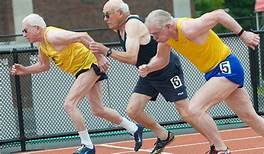
by the National Institute of Health (NIH)
Deciding to become physically active can be one of the best things you can do for your health. Exercise and physical activity are not only great for your mental and physical health, but they can help keep you independent as you age. Now, let’s talk about getting started.
How Much Activity Do Older Adults Need?
According to the Physical Activity Guidelines for Americans (PDF, 14.5M) you should do at least 150 minutes (2 ½ hours) a week of moderate-intensity aerobic exercise, like brisk walking or fast dancing. Being active at least 3 days a week is best, but doing anything is better than doing nothing at all. You should also do muscle-strengthening activities, like lifting weights or doing sit-ups, at least 2 days a week. The Physical Activity Guidelines also recommend that as part of your weekly physical activity you combine multiple components of exercises. For example, try balance training as well as aerobic and muscle-strengthening activities. If you prefer vigorous-intensity aerobic activity (like running), aim for at least 75 minutes a week.
How Older Adults Can Get Started with Exercise
Exercise and physical activity are great for your mental and physical health and help keep you independent as you age. Here are a few things you may want to keep in mind when beginning to exercise.
Start Slowly When Beginning Exercise
The key to being successful and safe when beginning a physical activity routine is to build slowly from your current fitness level. Over-exercising can cause injury, which may lead to quitting. A steady rate of progress is the best approach.
To play it safe and reduce your risk of injury:
Begin your exercise program slowly with low-intensity exercises.
Warm up before exercising and cool down afterward.
Pay attention to your surroundings when exercising outdoors.
Drink water before, during, and after your workout session, even if you don’t feel thirsty. Play catch, kickball, basketball, or soccer.
Wear appropriate fitness clothes and shoes for your activity.
If you have specific health conditions, discuss your exercise and physical activity plan with your health care provider.
Download and fill out the Find Your Starting Point Activity Log to document your starting point. You’ll find space to track your normal activity levels for a few days—try and choose a few weekdays and one weekend day.
Don’t forget to test your current fitness level for all 4 types of exercise—endurance, balance, flexibility, and strength. You may be in shape for running, but if you’re not stretching, you’re not getting the maximum benefit from your exercise. Write down your results so you can track your progress as you continue to exercise.
Make notes about how these test exercises feel. If the exercises were hard, do what’s comfortable and slowly build up. If they were easy, you know your level of fitness is higher. You can be more ambitious and challenge yourself.
Once you start exercising, use the Monthly Progress Test to check in and see how you are improving, and celebrate your successes!
